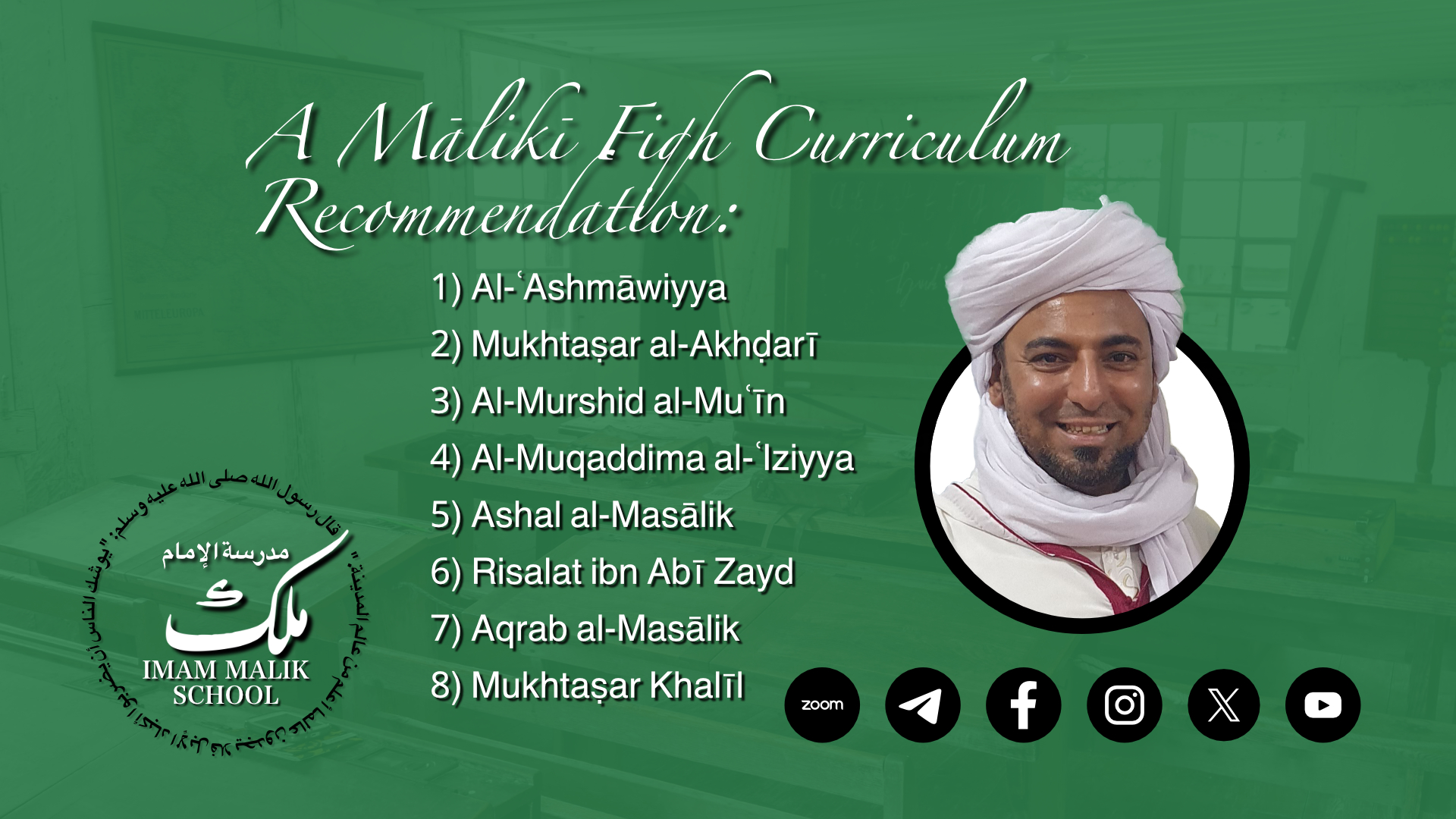Maliki Fiqh Curriculum

A Maliki Fiqh Curriculum Recommendation
The Maliki curriculum recommended by Sheikh Zuhayr Qazzan is as follows:
1) Al-ʿAshmāwiyya
2) Mukhtaṣar al-Akhḍarī
3) Al-Murshid al-Muʿīn
4) Al-Muqaddimatu al-ʿIziyya
5) Ashal al-Masālik
6) Risalat ibn Abī Zayd
7) Aqrab al-Masālik
8) Mukhtaṣar Khalīl
Sheikh Zuhayr constantly reminds us that curricula and teaching methods change over time, and that teachers need to adapt the method to the students. The reason for studying the above works is as follows:
ʿAshmāwiyya is preferable to start with for beginners because of its clear categorization.
Mukhtaṣar al-Akhḍari is at the same level as ʿAshmāwiyya, but builds on it with more questions. For example, it has an introduction to spirituality (tazkiyya) and other issues that the average Muslim should know – such as details about menstruation, prayer times and how to correct mistakes made in prayer.
This is followed by Ibn ʿĀshir’s Al-Murshid al-Muʿīn, which has an introduction to the doctrine of faith (ʿaqīda), the five pillars of Islam and an introduction to spirituality (taṣawwuf). The basic text is a poem of 313 lines that should be memorized.
Then Muqaddimat al-ʿIziyya is a good bridge between beginner-level and higher-level texts, with even more details in the previously mentioned areas of study. In addition, it has a brief introduction to family law, commerce and inheritance law.
Ashal al-Masālik follows, which is a poem of 1000 lines that should also be memorized. It contains the basics of all the chapters studied in jurisprudence, and serves as a simplified study of Mukhtaṣar Khalīl. It thus prepares the student to be able to keep up with advanced studies in jurisprudence. It also begins with a chapter on creed (ʿaqīda).
Next in line is Risalat Ibn Abī Zayd, which is one of the early texts written within the school, and is filled with blessings. The work begins with creed (ʿaqīda), followed by chapters on jurisprudence. It is not as structured as later texts written within the school, and hence Sheikh Zuhayr prefers that it be studied after Ashal al-Masālik. It can thus serve as a study for learning how to research within the school and deal with the school’s early texts.
Aqrab al-Masālik is also a simplification of Mukhtaṣar Khalīl, but is almost as detailed as Khalīl’s work. The advantages of Aqrab Al-Masālik are that the author Imam al-Dirdīr has removed the differences of opinion mentioned in Mukhtaṣar Khalīl and reorganized the text so that it is easier to follow. Imam al-Dirdīr also explains the stronger opinion within the school where Khalīl mentions a weak opinion within the school. In addition, he has also mentioned many definitions within jurisprudence, and developed the definitions that Ibn Arafa had developed. Finally, he has also exemplified many of the factual issues that Khalīl raises, by linking them to the time he himself lived in and explaining the criteria and conditions for the rulings in Mukhtaṣar Khalīl. This makes the work easier to apply based on varying circumstances.
Last but not least is Mukhtaṣar Khalīl, which has become the recognized work that all Malikis lean towards. It was written to give students an easy way to know what to issue fatwas on within the school, in the majority of the issues studied in jurisprudence (fiqh). According to many, one cannot be a mufti within the school without having studied, understood, memorized, and applied this text. Some have even mentioned that one must read all its commentaries once a year to qualify as a mufti. There are more than 200 commentaries that have been written explaining the Mukhtaṣar Khalīl, as it is the main text that the Malikis turn to within the school. The previously written texts are quoted and discussed in those commentaries, making the Mukhtaṣar Khalīl the starting point for the entire school. A fantastic and well-studied text that no scholar in the school can ignore, not since the time of Khalīl at least.
